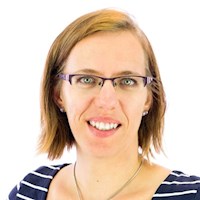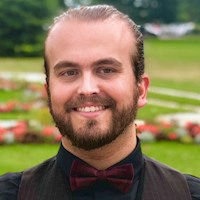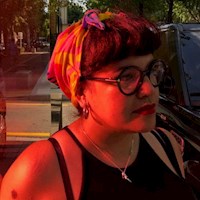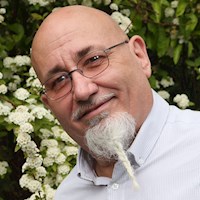



Changing the Face of Autism Research Together is a collaborative project led by a committed team of people who believe in participatory research in its truest sense.
Dr Kinga Bercsenyi
 Kinga devised, designed and coordinated the project. It was Kinga that sought and secured funding from the Wellcome Trust and then put together a brilliant team to see her creative vision through to fruition. Kinga is Sir Henry Wellcome Fellow at the Centre for Developmental Neurobiology at King’s College London and Champion for Translational Neuroscience at the NIHR Maudsley Biomedical Research Centre. Her research focuses on how the brain develops, with a specific focus on the balance between so-called ‘go’ and ‘no go’ cells, which is important for brain cells to communicate effectively as a network. She likens this to a dinner party with a mix of ‘talkers’ and ‘listeners’ – you have to get the mix right to have a healthy conversation!
Kinga devised, designed and coordinated the project. It was Kinga that sought and secured funding from the Wellcome Trust and then put together a brilliant team to see her creative vision through to fruition. Kinga is Sir Henry Wellcome Fellow at the Centre for Developmental Neurobiology at King’s College London and Champion for Translational Neuroscience at the NIHR Maudsley Biomedical Research Centre. Her research focuses on how the brain develops, with a specific focus on the balance between so-called ‘go’ and ‘no go’ cells, which is important for brain cells to communicate effectively as a network. She likens this to a dinner party with a mix of ‘talkers’ and ‘listeners’ – you have to get the mix right to have a healthy conversation!
Kinga says: “I am a firm believer that the only way modern science can serve society is if it involves and communicates with communities. I was compelled to make this project happen to bring together the autistic community and researchers like myself, to find ways for us all to influence autism research together.
"By encouraging people to be creative, honest and open, and to have fun expressing themselves, we’ve been able to dismantle some of the barriers we unwittingly create every day. Some really valuable conversations have come out of it all, such as: what does ‘participatory research’ mean and what we could do to make it work better? The portraits, podcasts and discussions show that we’re really all just individuals trying to make sense of ourselves and the world.
"I hope the portraits and podcasts challenge people’s preconceptions about autism and help us all to appreciate and embrace neurodiversity. In particular, I hope that more researchers like myself will feel inspired to reach out to the autistic community, ask their views, and make sure their priorities shape the future of research on autism.”
Mario Ruiz Sorube
 Mario is one of the artists-in-residence for this project. He works as a digital illustrator, with portraiture as his speciality, and has co-created the portraits of all the participants involved. He is also a chemist by background and finished his MPhil in Cellular Biology at University College London a few years ago.
Mario is one of the artists-in-residence for this project. He works as a digital illustrator, with portraiture as his speciality, and has co-created the portraits of all the participants involved. He is also a chemist by background and finished his MPhil in Cellular Biology at University College London a few years ago.
Mario says: “Although I left the world of science after my MPhil, I believe that a connection between scientific research and communities is still missing, or is not strong enough, in many areas. Thanks to this project a way to create and strengthen these bonds, using art to push boundaries and spark dialogue, has definitely opened up.”
Mónica Arevalo Silva
 Mónica is the producer and curator of the exhibition. She fell in love with the concept developed by Kinga, Mario and Jon, and her aim was to translate their vision into the visitor’s experience.
Mónica is the producer and curator of the exhibition. She fell in love with the concept developed by Kinga, Mario and Jon, and her aim was to translate their vision into the visitor’s experience.
Her background is diverse, with a BA in Graphic Design and an MA in Film and Screen studies focused on Race and Gender. Meeting the team and getting involved in this project seemed like the perfect occasion to restart her career as curator, which she left on stand-by when moving from Spain.
Monica says: “I got personally inspired by the project as its aim is to create a bond between people and concepts. Instead of splitting the members of a community into little categories, it aims to bring them together and create a much needed conversation between them. I wish there were more projects like this as better communication is key to moving forward as a society.”
Jon Adams
 Jon’s work is cross-platform, including digital and analogue image making, book illustration, video, poetry, sound, performance, written and spoken word, referencing his synaesthesia, his autism and dyslexia, his autobiography, as well as science and hidden metaphor. The result is a unique visual perspective of systemising and recording history, time and place.
Jon’s work is cross-platform, including digital and analogue image making, book illustration, video, poetry, sound, performance, written and spoken word, referencing his synaesthesia, his autism and dyslexia, his autobiography, as well as science and hidden metaphor. The result is a unique visual perspective of systemising and recording history, time and place.
He studied geology at King’s College London, becoming a geological book illustrator, later branching out into history and conceptual artwork. His portfolio includes work across a wide range of institutions, organisations and genres from Parliament, the ARC, and London 2012, as well as work with Sir Peter Brook.
He is also artistic director of a new equality and diversity charity called ‘Flow Observatorium’. It is an advocacy support and research artist led cluster calling for parity and recognition of neurodiversity within the arts. Their Neurodivergent Artist Manifesto, released in 2017, is being used internationally.
As a researcher, Jon has published papers on peer participation in ‘autism research’ and actively taking part in advocating and promoting research into mental health and suicide in autism with the University of Nottingham. He is interested in the wellbeing and mental health of autistic artists as well as ways of breaking down barriers to inclusion for participants, artists and audiences.
Jon says: “I really believe it’s important to involve autistic people at every level of autism research - just like in the arts we should be involved, not only through participating, but also informing the direction and ideas for autism research. I’d like to see research initiated by autistic people’s needs rather than what is assumed we may need. Researchers need to meet and sit with autistic people, to see us as fellow human beings, not people with a condition or somehow broken by being different.
“I hope people will listen to these conversations and look at the portraits and be inspired to bring autistic people and researchers together in a way that is mutually beneficial. We have a lot to learn from each other, but research has to reflect the wishes of people to live fulfilled and healthy lives, not impose treatments, cures or preventions upon us. Involvement in autism research ensures equity, preventing research from excluding our views and needs.”